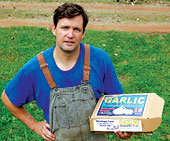
photo by Kent Priestley
|
Tom Sherry’s Whistlepig Farm, which is situated in Hominy Valley near Candler, seems to be more or less free of vampires, a fact which has allowed him to concentrate on growing a business.
“I’m a free bleeder,” Sherry says, speaking on matters circulatory. Garlic, among its other curative powers, is a natural blood-thinner, something vampires ought to like but apparently can’t get their fangs around. So be it. If growing and eating lots of garlic (“I usually use two heads in any given recipe,” Sherry says) is a social liability, this farmer hasn’t noticed it. He’s been in demand at local farmers’ markets since customers first got wind of his product.
“People don’t freak out over kale,” Sherry says with a wry smile. “They don’t freak out over cauliflower. They do freak out over garlic. People get a rush over certain food items, and garlic is one of those. With good garlic you can make someone smile.”
Sherry got his own freak on one spring morning a number of years ago when he saw a scape – a garlic plant’s elegant, curlicue of a flower bud – emerging from a head. It was one of those moments where everything else – the national debt, the threat of nuclear war, Michael Jackson’s latest capers – stopped mattering.
“I didn’t know anything about scapes,” Sherry says. “But then I saw this thing rising out of the plant. Right then I was like, ‘That’s it. It’s over. I’m sold.'”
In late summer, Sherry’s seven-acre organic farm has a charmingly bedraggled feel. A lower, creek-bottom field and an upper field, flush now with weeds, are bisected by a beneficial insect preserve – a rampant, colorful patch of nectar-bearing plants. An old pear tree by Sherry’s white frame house is heavy with fruit; same for an English walnut tree nearby. A pair of hogs grunts lazily near the barn.
“Organization is not my strong suit,” he confesses.
In Sherry’s company, it’s easy to feel that ours is a garlic-impoverished nation. Outside of certain gustatory circles, most Americans know of only one kind of garlic: the soft-neck style grown in California’s central valley, with its trademark ruffle of papery skins cloaking each clove. “Garlic,” people call it.
But there are hundreds of varieties of garlic around the world – hard necks, soft necks, turbans, artichokes, porcelains, heat-loving Creoles, rocamboles. Some have colorful wrappers, satiny wrappers or pearly wrappers. Others are marked with stripes of red, blue or purple. Some have dense, layered bulbs; others are loose and easy-to-peel. The varieties also carry a diversity of flavors, from mild to hot-as-homegrown-sin.
“Finding out about these varieties is like living in a world where all you know is Pabst Blue Ribbon, and then one day someone hands you a really nice I.P.A,” Sherry says.
Inside Sherry’s barn, this year’s crop hangs in heavy bunches, waiting to be sorted. Each variety is marked with a plastic ribbon, the name written on it.
“Garlic originated in Siberia,” Sherry explains. “And then it moved west with the spice trade.”
In Egypt, garlic’s nutrients and restorative qualities helped get the pyramids built. The Greeks and Romans praised it for its ability to repel scorpions. In 14th century Europe, it was thought to ward off the plague. And then there is the matter of vampires.
In fact, many of the nearly 40 varieties Sherry grows have origins in Eastern Europe, which, from time-to-time, has been a global center of undead activity. Consider “Glazer,” “Broadleaf Czech,” “Pskem,” “Red Rezan,” and the pointedly named “Transylvanian.”
Globally speaking, Koreans consume more garlic per capita than any other culture, a fact that long ago became a stigma in the eyes (or noses, rather) of their more buttoned-up neighbors, the Japanese. Many of Sherry’s more poetically named varieties (“Lotus,” “Asian Tempest”) come from Asia.
Sherry is part of a long line of garlic growers stewarding this impressive diversity. It’s not a cheap pursuit, either; garlic is propagated by planting individual cloves, most of which Sherry has to order from specialty growers. Over the course of six years, he’s built up a considerable bank of heirloom varieties, but it’s slow, plodding work.
A few years ago, he grabbed the Internet domain name www.garlicfreak.com to help him market the pungent, organically grown fruit of his labors. And while the intensive nature of garlic-growing and the economies of scale at Whistlepig Farm may never make Candler, N.C., a threat to Gilroy, Calif. (the self-titled “Garlic Capital of the World”), Sherry’s passion for the plant nevertheless has a whiff of missionary zeal about it.
“Garlic doesn’t fit into any real food category,” he insists. “It’s not considered a vegetable, it’s not considered a spice, it’s not considered an herb. Garlic exists in its own little universe.”
Come to think of it, Sherry may be more than just a handsome guy with an odd passion. He may be a visionary in threadbare Carhartts.
“People say, ‘It’s just garlic.’ And I tell them, yeah, well, in 1980, coffee was ‘just coffee’ and in 1990 beer was ‘just beer.’ In 2006, garlic may just be garlic, but go to a supermarket now and there are 45 different kinds of coffee and 150 kinds of beer. It could be the same for garlic one day. We’re at the front end of that curve.”
Tom Sherry’s Whistlepig Farm garlic samplers are sold at Laurey’s Catering, which is located at 67 Biltmore Ave. in Asheville, and can also be ordered on his Web site: www.garlicfreak.com.



Hi, Tom. Eric Ryan and his family are here(Nags Head) for a few days, and we were reminiscing about TFA and Woodland, etc and of course we thought of you. Hope you are doing well. Would love to catch up with you. John & June..